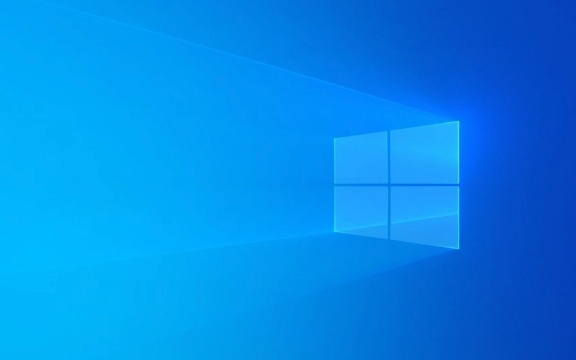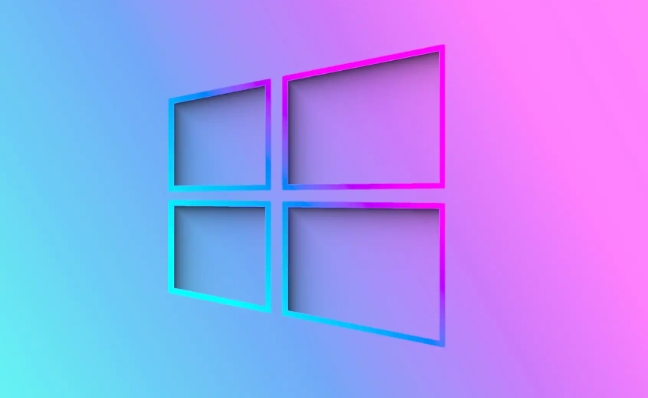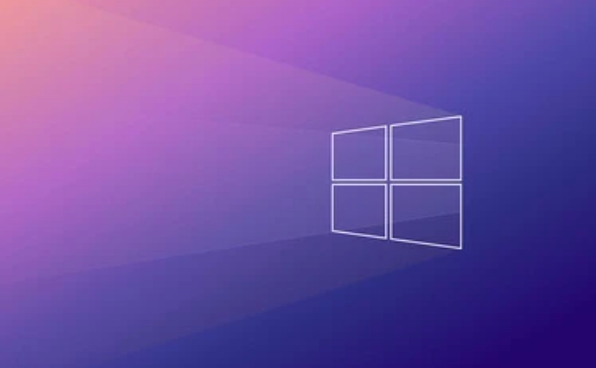Windows automatic repair loop fix
Use the installation media to enter the recovery environment; 2. Run the bootrec command to repair the boot records; 3. Check for disk errors and repair system files; 4. Disable automatic repair as a temporary means. The Windows automatic repair loop is usually caused by system files corruption, hard disk errors or boot configuration abnormalities. The solution includes troubleshooting by installing the USB flash drive into the recovery environment, using bootrec to repair MBR and BCD, running chkdsk and DISM/sfc to repair disk and system files. If it is invalid, the automatic repair function can be temporarily disabled, but the root cause needs to be checked later to ensure that the hard disk and boot structure are normal.

Windows automatically repairs loop problems, which usually happens when the system cannot boot normally. At this time, the "automatic repair" interface will be repeatedly entered. Trying to repair but it will never succeed. This situation is mostly caused by system files, hard disk errors, or abnormal startup configuration data.

If you encounter this problem, the following methods can help you solve it.

1. Use the installation media to enter the recovery environment
If your computer is stuck in the "trying to repair your computer", the most direct way is to install the USB disk or CD through Windows to enter the recovery environment.
- Insert the installation media and restart the computer
- Select Start from USB drive (usually F12, Esc, or Delete keys) in the BIOS or boot menu
- After entering, select the language and keyboard settings and click "Next"
- Click "Repair Computer" > "Troubleshooting" > "Advanced Options"
Here you can execute command prompt, system restore, start repair and other operations.

2. Run the bootrec command to repair the boot record
In the command prompt mentioned above, enter the following command:
-
bootrec /fixmbr -
bootrec /fixboot -
bootrec /rebuildbcd
These three steps are used to repair the main boot record, write the startup sector, and rebuild the BCD (start configuration data). If the hard disk partition is not seriously damaged, it can generally solve the problem.
Note: If the system partition is not found, it may be because there is a problem with the partition table, or there is a physical bad channel on the hard disk.
3. Check for disk errors and repair system files
Sometimes system files are corrupted and can also cause an automatic repair loop. You can try running the following command:
chkdsk /f /r
Check and fix disk errors, the process can take several minutes.DISM /Image:C:\ /Cleanup-Image /RestoreHealth
(Note: C: It is the system disk, modified according to actual conditions)
If DISM completes successfully, run again:sfc /scannow /offbootdir=C:\ /offwindir=C:\Windows
This step will scan the system files and try to repair them.
4. Disable automatic repair as a temporary means
If none of the above methods work, you can try to temporarily turn off the automatic repair function:
Run in the command prompt:
-
bcdedit /set {default} recoveryenabled No -
bcdedit /set bootstatuspolicy ignoreallfailures
This allows the system to skip the automatic repair process and try to start directly. But this is just bypassing the problem and cannot be completely solved. It is recommended that the root cause be fixed in the future.
Basically these common methods. The situation is different for each computer and it may require multiple steps to solve it in combination. When encountering this kind of problem, don’t worry, check it step by step, the key is to confirm that the hard drive is fine and the system boot structure is complete.
The above is the detailed content of Windows automatic repair loop fix. For more information, please follow other related articles on the PHP Chinese website!

Hot AI Tools

Undress AI Tool
Undress images for free

Undresser.AI Undress
AI-powered app for creating realistic nude photos

AI Clothes Remover
Online AI tool for removing clothes from photos.

Clothoff.io
AI clothes remover

Video Face Swap
Swap faces in any video effortlessly with our completely free AI face swap tool!

Hot Article

Hot Tools

Notepad++7.3.1
Easy-to-use and free code editor

SublimeText3 Chinese version
Chinese version, very easy to use

Zend Studio 13.0.1
Powerful PHP integrated development environment

Dreamweaver CS6
Visual web development tools

SublimeText3 Mac version
God-level code editing software (SublimeText3)

Hot Topics
 Go for Audio/Video Processing
Jul 20, 2025 am 04:14 AM
Go for Audio/Video Processing
Jul 20, 2025 am 04:14 AM
The core of audio and video processing lies in understanding the basic process and optimization methods. 1. The basic process includes acquisition, encoding, transmission, decoding and playback, and each link has technical difficulties; 2. Common problems such as audio and video aberration, lag delay, sound noise, blurred picture, etc. can be solved through synchronous adjustment, coding optimization, noise reduction module, parameter adjustment, etc.; 3. It is recommended to use FFmpeg, OpenCV, WebRTC, GStreamer and other tools to achieve functions; 4. In terms of performance management, we should pay attention to hardware acceleration, reasonable setting of resolution frame rates, control concurrency and memory leakage problems. Mastering these key points will help improve development efficiency and user experience.
 Using the Translator facade for Localization in Laravel.
Jul 21, 2025 am 01:06 AM
Using the Translator facade for Localization in Laravel.
Jul 21, 2025 am 01:06 AM
TheTranslatorfacadeinLaravelisusedforlocalizationbyfetchingtranslatedstringsandswitchinglanguagesatruntime.Touseit,storetranslationstringsinlanguagefilesunderthelangdirectory(e.g.,en,es,fr),thenretrievethemviaLang::get()orthe__()helperfunction,suchas
 SQL for Predictive Analytics
Jul 20, 2025 am 02:02 AM
SQL for Predictive Analytics
Jul 20, 2025 am 02:02 AM
In predictive analysis, SQL can complete data preparation and feature extraction. The key is to clarify the requirements and use SQL functions reasonably. Specific steps include: 1. Data preparation requires extracting historical data from multiple tables and aggregating and cleaning, such as aggregating sales volume by day and associated promotional information; 2. The feature project can use window functions to calculate time intervals or lag features, such as obtaining the user's recent purchase interval through LAG(); 3. Data segmentation is recommended to divide the training set and test set based on time, such as sorting by date with ROW_NUMBER() and marking the collection type proportionally. These methods can efficiently build the data foundation required for predictive models.
 Advanced Java Collection Framework Optimizations
Jul 20, 2025 am 03:48 AM
Advanced Java Collection Framework Optimizations
Jul 20, 2025 am 03:48 AM
To improve the performance of Java collection framework, we can optimize from the following four points: 1. Choose the appropriate type according to the scenario, such as frequent random access to ArrayList, quick search to HashSet, and concurrentHashMap for concurrent environments; 2. Set capacity and load factors reasonably during initialization to reduce capacity expansion overhead, but avoid memory waste; 3. Use immutable sets (such as List.of()) to improve security and performance, suitable for constant or read-only data; 4. Prevent memory leaks, and use weak references or professional cache libraries to manage long-term survival sets. These details significantly affect program stability and efficiency.
 Go for Network Device Management
Jul 19, 2025 am 03:07 AM
Go for Network Device Management
Jul 19, 2025 am 03:07 AM
Go language is suitable for network device management due to its concurrency model and high performance. 1. Connecting devices can use third-party libraries such as x/crypto/ssh to achieve SSH connection and execute CLI commands; 2. Bulk management can control the concurrency through goroutine channel to ensure reasonable utilization of resources; 3. Processing manufacturer compatibility can achieve scalability by defining the DeviceHandler interface to customize handlers for different brands of devices.
 Java Virtual Threads Performance Benchmarking
Jul 21, 2025 am 03:17 AM
Java Virtual Threads Performance Benchmarking
Jul 21, 2025 am 03:17 AM
Virtual threads have significant performance advantages in highly concurrency and IO-intensive scenarios, but attention should be paid to the test methods and applicable scenarios. 1. Correct tests should simulate real business, especially IO blocking scenarios, and use tools such as JMH or Gatling to compare platform threads; 2. The throughput gap is obvious, and it can be several times to ten times higher than 100,000 concurrent requests, because it is lighter and efficient in scheduling; 3. During the test, it is necessary to avoid blindly pursuing high concurrency numbers, adapting to non-blocking IO models, and paying attention to monitoring indicators such as latency and GC; 4. In actual applications, it is suitable for web backend, asynchronous task processing and a large number of concurrent IO scenarios, while CPU-intensive tasks are still suitable for platform threads or ForkJoinPool.
 Microsoft Edge high disk usage
Jul 20, 2025 am 12:57 AM
Microsoft Edge high disk usage
Jul 20, 2025 am 12:57 AM
1. Extended plug-ins may frequently read and write disks. It is recommended to uninstall or disable infrequently used plug-ins and pay special attention to ad blocking plug-ins; 2. Cache and temporary file accumulation will cause disk occupancy exceptions. You can clear browsing data or manually delete cached files through settings; 3. Background processes and preload functions may continue to occupy disks, so you need to turn off the "Start Enhancement" function and check the background process; 4. Update problems or bugs may cause exceptions, you can check for update versions, rollback or reset browser settings. In response to the soaring problem of Edge hard drive occupation, checking plug-ins, caches, background functions and updates can be effectively solved.
 Java Virtual Threads and Goroutines Comparison
Jul 20, 2025 am 03:27 AM
Java Virtual Threads and Goroutines Comparison
Jul 20, 2025 am 03:27 AM
Both VirtualThreads in Java and Goroutines in Go are designed to improve the performance of high-concurrency scenarios, but the implementation mechanism and ecological support are different. 1. In terms of scheduling mechanism, VirtualThreads is managed by the JVM and scheduling through ForkJoinPool, while Goroutines is managed by the scheduler owned by Goruntime. It adopts the M:N model and has more mature scheduling capabilities; 2. In terms of startup cost, Goroutines starts faster and has a simpler syntax. It only requires gofunc(). Java uses Thread.ofVirtual().start() to create virtual threads, which is relatively cumbersome but more efficient than traditional threads.







